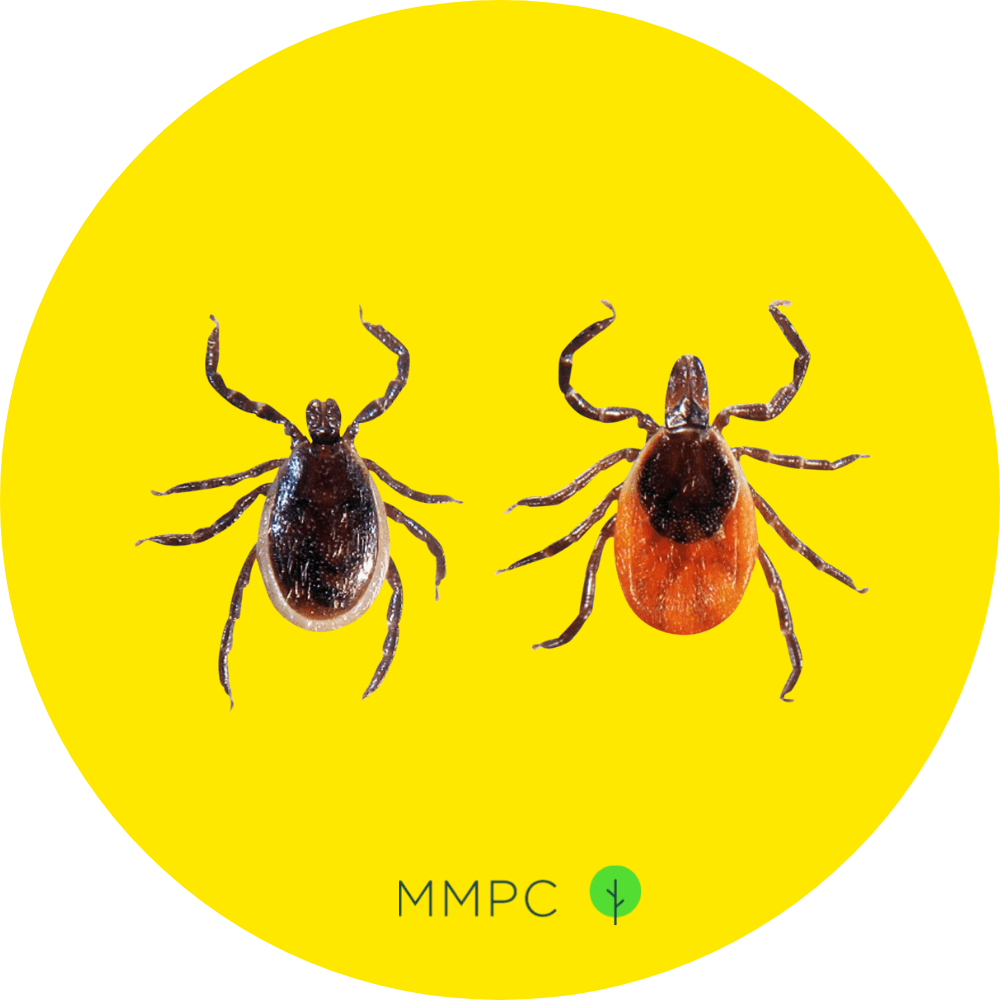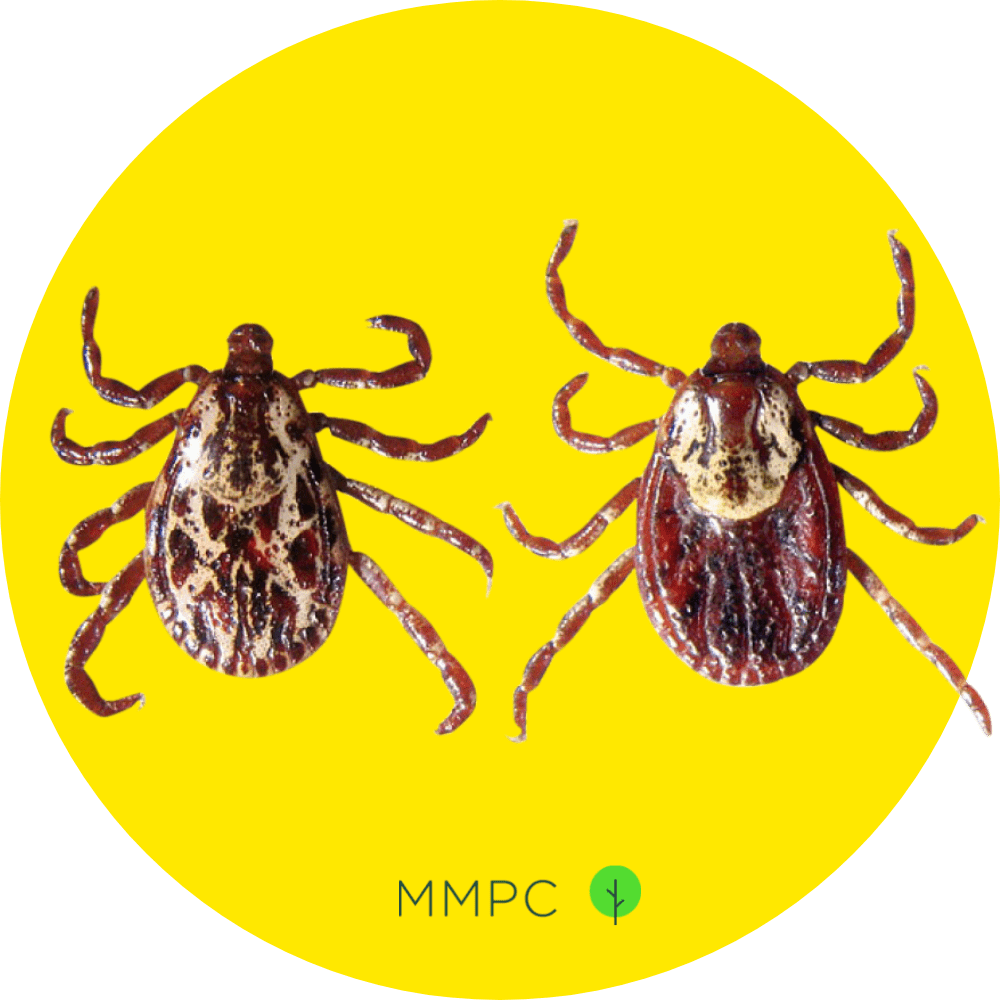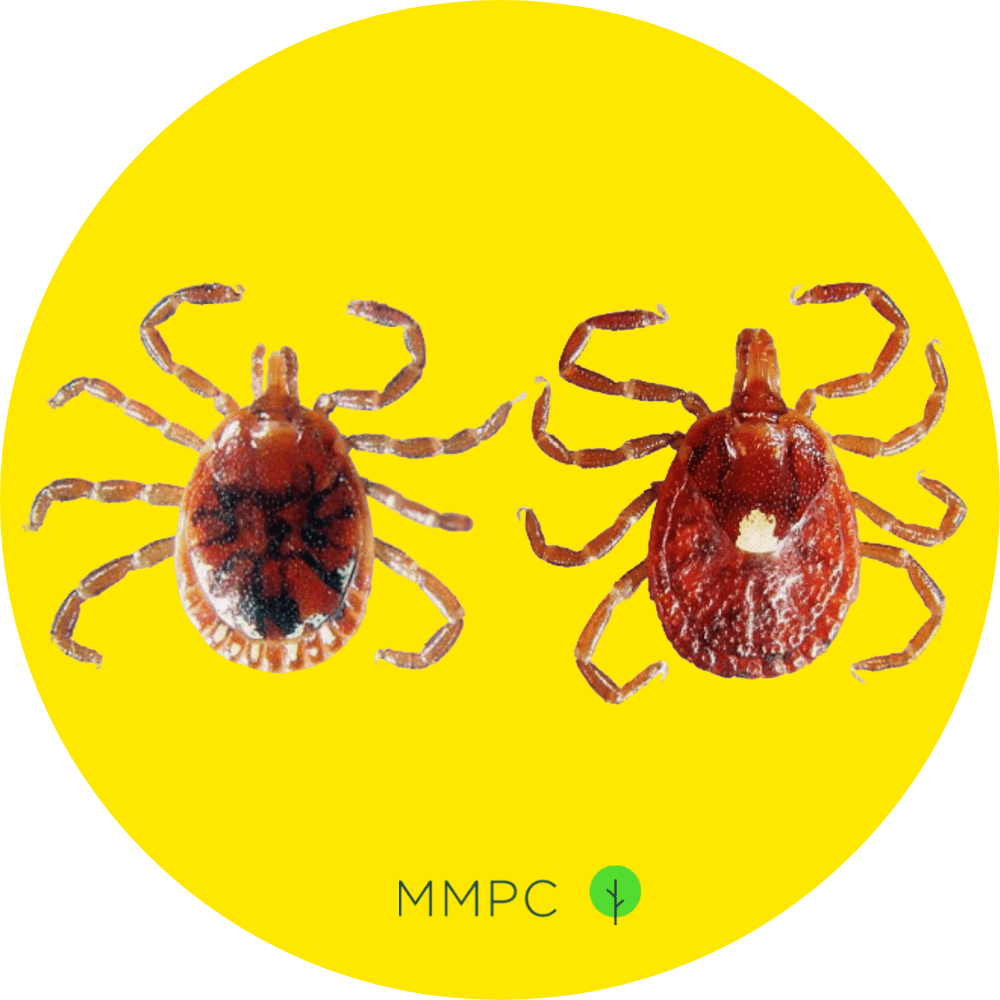
Not all ticks carry bacteria that are dangerous to humans (like the ones that causes Lyme, for example). Depending on where you live, the chances of catching a tick-borne disease can be as low as 1% or more than 50%.
An uninfected tick bite temporarily leaves the surrounding skin red and irritated. But if the condition of your skin worsens in the days and weeks following the bite, it’s possible that you were bitten by an infected tick.
This article covers some of the most common tick-borne diseases and the signs and symptoms to look out for.
What Types of Ticks Transmit Disease?
In New York, there are three common tick species that are known to transmit potentially serious diseases to humans:
1. Blacklegged Ticks (Deer Ticks)
The blacklegged tick, also known as the deer tick, is the smallest species of tick in the United States. Female deer ticks can be recognized by their orange-red bodies.
This species is most commonly associated with Lyme disease but they can also carry other diseases like anaplasmosis, babesiosis, and Powassan virus disease.

Lyme Disease
Lyme disease is the most common tick-borne disease in the United States, according to the CDC. It’s caused by the bacterium Borrelia burgdorferi.
In most cases, a tick must be attached for 36–48 hours before the disease-causing bacterium can be transmitted, which is why it’s so important to check for ticks and remove them as quickly as possible.
After a person is bitten by an infected deer tick, one of the earliest symptoms of Lyme disease is a characteristic rash on the skin resembling a target or a bullseye (the medical term for this rash is erythema migrans). Not everyone will get this rash though; it only appears in 70–80 percent of infected people.
It starts as a fast-growing, circular patch of redness around the bite, usually starting 3–30 days after the initial tick bite. Over time, the color in the middle of the rash lightens up, leaving only a red center and a red outer ring.
Symptoms of Lyme disease include:
- Erythema migrans (bullseye rash)
- Fever
- Chills
- Headache
- Fatigue
- Muscle and joint aches
- Swollen lymph nodes
Anaplasmosis
Anaplasmosis is a less common tick-borne disease caused by the bacterium Anaplasma phagocytophilum. There are typically fewer than 100 cases reported in New York City annually.
Signs and symptoms typically begin within 1–2 weeks after a bite from the infected tick. Unlike Lyme disease, anaplasmosis is harder to recognize because its symptoms are rather nonspecific. Blood work is usually required to properly diagnose anaplasmosis.
Symptoms of anaplasmosis include:
- Fever
- Chills
- Severe headache
- Muscle aches
- Nausea
- Vomiting
- Diarrhea
- Loss of Appetite
- Confusion
Babesiosis
According to the New York State Department of Health, babesiosis is a rare, sometimes severe, tick-transmitted disease caused by a microscopic, blood-borne parasite called Babesia microti.
An infected person might not develop signs or symptoms of babesiosis. In fact, many people feel fine and don’t ever become sick enough to require treatment.
But in some cases, babesiosis can lead to serious health problems. The most common is hemolytic anemia, which usually develops after 2–9 weeks, leading to jaundice, yellowing of the skin, and dark urine. Other rare but severe consequences include blood clots, organ failure, and even death.
Symptoms of babesiosis include:
- Fever
- Chills
- Sweats
- Headaches
- Body aches
- Loss of appetite
- Nausea
- Fatigue
Powassan Virus Disease
Unlike other tick-borne diseases, the transmission of Powassan virus from an infected tick bite occurs very quickly—as soon as 15 minutes after attachment.
Although it’s relatively rare in New York (only 1–2 cases per year), in some cases it can potentially cause severe health consequences like encephalitis and meningitis.
Many people infected with Powassan virus only experience mild symptoms, which might appear within 1–4 weeks after the tick bite. Some people don’t show any symptoms at all. In fact, it’s believed that most people who get infected produce antibodies to neutralize the infection naturally.
Symptoms of Powassan virus disease include:
- Fever
- Headache
- Vomiting
- Generalized weakness
- Seizures
2. American Dog Ticks
The American dog tick, also known as the wood tick, is a relatively large species of ticks that can be identified by mottled white markings on their bodies.
The main tick-borne diseases associated with their bites include Rocky Mountain spotted fever and tularemia.

Rocky Mountain Spotted Fever
Rocky Mountain spotted fever (RMSF) is an acute disease that affects both humans and dogs. While people of any age can get RSMF, the frequency of cases is higher in children under the age of 15.
The disease is caused by the bacterium Rickettsia rickettsii, and the average incubation period is around 5–10 days after the initial tick bite.
One of the most recognizable symptoms is a spotted skin rash. It usually develops over the course of 2–5 days. First, pale spots appear on the person’s hands, feet, forearms, and ankles. After about a week, the rash develops into a large number of small, bright red spotted lesions.
Symptoms of Rocky Mountain spotted fever include:
- Spotted rash
- Fever
- Chills
- Sore throat
- Headache
- Muscle aches
- Stomach pain
- Lack of appetite
- Nausea
- Vomiting
Tularemia
Tularemia, sometimes referred to as “rabbit fever” or “deer fly fever,” is a disease caused by the bacterium Francisella tularensis. It most often affects animals, especially rabbits and rodents, but in rare cases it can also be transmitted to people from the bite of an infected tick or deer fly.
Tularemia typically attacks the skin, eyes, lymph nodes, and lungs. While it can be potentially life-threatening, most of the time it can be treated effectively with antibiotics when diagnosed early.
The incubation period of tularemia is usually around 1–10 days, and most people who get sick develop symptoms within 3–5 days.
There are several types of tularemia, but the most common form is called ulceroglandular tularemia. The most distinguishing feature is the development of a skin ulcer around the site of the infected tick bite. It’s also accompanied by swollen and painful lymph glands, usually around the armpit or groin.
Symptoms of ulceroglandular tularemia include:
- Skin ulcer
- Swollen lymph glands
- Fever
- Chills
- Headache
- Fatigue
- Muscle aches
- Joint pain
- Diarrhea
- Cough
- Weakness
3. Lone Star Ticks
The lone star tick is easily identifiable due to the white dot on the back of the adult females. It’s known for being a relatively aggressive species that can transmit diseases like ehrlichiosis and tularemia.

Ehrlichiosis
According to the CDC, ehrlichiosis is a general term used to describe a range of diseases caused by the bacteria Ehrlichia chaffeensis, E. ewingii, and E. muris eauclairensis. Not only does it affect humans, ehrlichiosis is of significant concern for dogs and other animals as well.
In order for this disease to be transmitted to a human host, an infected tick must be attached for at least 12–24 hours. Symptoms of ehrlichiosis usually begin to appear within 14 days following the tick bite.
The early symptoms are usually mild, moderate, and nonspecific. Approximately 1 in 3 people develop a rash that resembles red splotches or pinpoint dots. This rash is more common in children than adults.
Early diagnosis and treatment with antibiotics is important. If left untreated, the disease can lead to life-threatening complications, including meningoencephalitis, respiratory failure, bleeding, and organ failure.
Symptoms of ehrlichiosis include:
- Rash
- Fever
- Chills
- Headache
- Malaise
- Muscle aches
- Joint pain
- Nausea
- Vomiting
- Diarrhea
- Loss of appetite
- Confusion
Tularemia
Lone star ticks can also transmit tularemia to people (see above).
About MMPC
If you have concerns about ticks in your backyard or on your property, MMPC can help. Based in New York City, MMPC specializes in using effective and eco-friendly methods to protect your home and family from mosquitoes, ticks, and other pests.
